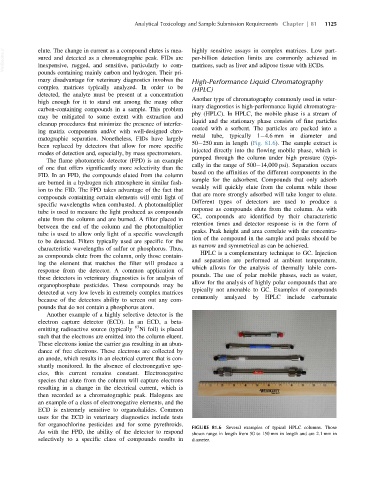Page 1193 - Veterinary Toxicology, Basic and Clinical Principles, 3rd Edition
P. 1193
Analytical Toxicology and Sample Submission Requirements Chapter | 81 1125
VetBooks.ir elute. The change in current as a compound elutes is mea- highly sensitive assays in complex matrices. Low part-
per-billion detection limits are commonly achieved in
sured and detected as a chromatographic peak. FIDs are
matrices, such as liver and adipose tissue with ECDs.
inexpensive, rugged, and sensitive, particularly to com-
pounds containing mainly carbon and hydrogen. Their pri-
mary disadvantage for veterinary diagnostics involves the High-Performance Liquid Chromatography
complex matrices typically analyzed. In order to be
(HPLC)
detected, the analyte must be present at a concentration
Another type of chromatography commonly used in veter-
high enough for it to stand out among the many other
inary diagnostics is high-performance liquid chromatogra-
carbon-containing compounds in a sample. This problem
phy (HPLC). In HPLC, the mobile phase is a stream of
may be mitigated to some extent with extraction and
liquid and the stationary phase consists of fine particles
cleanup procedures that minimize the presence of interfer-
coated with a sorbent. The particles are packed into a
ing matrix components and/or with well-designed chro-
metal tube, typically 1 4.6 mm in diameter and
matographic separation. Nonetheless, FIDs have largely
50 250 mm in length (Fig. 81.6). The sample extract is
been replaced by detectors that allow for more specific
injected directly into the flowing mobile phase, which is
modes of detection and, especially, by mass spectrometers.
pumped through the column under high pressure (typi-
The flame photometric detector (FPD) is an example
cally in the range of 500 14,000 psi). Separation occurs
of one that offers significantly more selectivity than the
based on the affinities of the different components in the
FID. In an FPD, the compounds eluted from the column
sample for the adsorbent. Compounds that only adsorb
are burned in a hydrogen rich atmosphere in similar fash-
weakly will quickly elute from the column while those
ion to the FID. The FPD takes advantage of the fact that
that are more strongly adsorbed will take longer to elute.
compounds containing certain elements will emit light of
Different types of detectors are used to produce a
specific wavelengths when combusted. A photomultiplier
response as compounds elute from the column. As with
tube is used to measure the light produced as compounds
GC, compounds are identified by their characteristic
elute from the column and are burned. A filter placed in
retention times and detector response is in the form of
between the end of the column and the photomultiplier
peaks. Peak height and area correlate with the concentra-
tube is used to allow only light of a specific wavelength
tion of the compound in the sample and peaks should be
to be detected. Filters typically used are specific for the
as narrow and symmetrical as can be achieved.
characteristic wavelengths of sulfur or phosphorus. Thus,
HPLC is a complementary technique to GC. Injection
as compounds elute from the column, only those contain-
and separation are performed at ambient temperature,
ing the element that matches the filter will produce a
which allows for the analysis of thermally labile com-
response from the detector. A common application of
pounds. The use of polar mobile phases, such as water,
these detectors in veterinary diagnostics is for analysis of
allow for the analysis of highly polar compounds that are
organophosphate pesticides. These compounds may be
typically not amenable to GC. Examples of compounds
detected at very low levels in extremely complex matrices
commonly analyzed by HPLC include carbamate
because of the detectors ability to screen out any com-
pounds that do not contain a phosphorus atom.
Another example of a highly selective detector is the
electron capture detector (ECD). In an ECD, a beta-
emitting radioactive source (typically 63 Ni foil) is placed
such that the electrons are emitted into the column eluent.
These electrons ionize the carrier gas resulting in an abun-
dance of free electrons. These electrons are collected by
an anode, which results in an electrical current that is con-
stantly monitored. In the absence of electronegative spe-
cies, this current remains constant. Electronegative
species that elute from the column will capture electrons
resulting in a change in the electrical current, which is
then recorded as a chromatographic peak. Halogens are
an example of a class of electronegative elements, and the
ECD is extremely sensitive to organohalides. Common
uses for the ECD in veterinary diagnostics include tests
for organochlorine pesticides and for some pyrethroids.
FIGURE 81.6 Several examples of typical HPLC columns. Those
As with the FPD, the ability of the detector to respond shown range in length from 50 to 150 mm in length and are 2.1 mm in
selectively to a specific class of compounds results in diameter.

